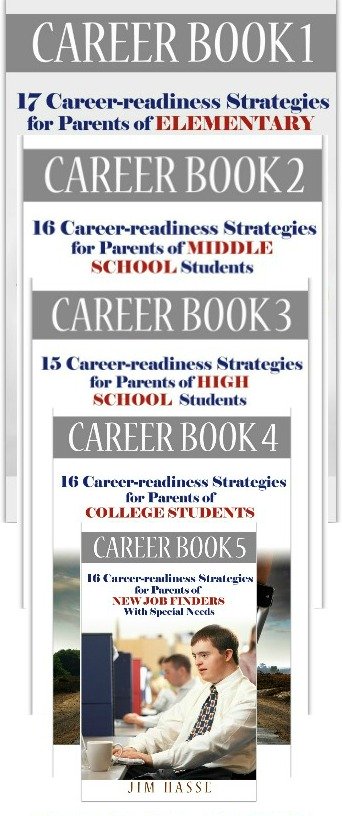Part-time
Jobs: Cerebral Palsy
Career Builders for High School Students
By Jim Hasse, ABC, GCDF, Disability Employment Expert
_________________________________________________________
Working in part-time
jobs, even with cerebral palsy (CP), gives high school students an opportunity to gain valuable work experience.
It's part of the road map created by the National Career Development guidelines, which outlines 11 skills your youngster needs to learn at the "knowledge acquisition" level during high school. See links to my 20 individual articles in this section about how to develop those skills.
Gaining work experience through part-time jobs during high school is essential in competing effectively in today’s job market because it gives
your son or daughter an opportunity to hone the “soft” work skills every employer now seeks in
a job candidate.
That statement comes from Jennifer N. Kemp,
Youth Policy Team Leader, Office of Disability Employment Policy, U.S.
Department of Labor.
“I’ve had a dozen part-time jobs -- from fudge maker and baby
sitter to editorial assistant,” says Kemp, who has CP.
“I’ve never really faced the situation where I couldn’t get a job when I wanted
one,” she adds, looking back on her career of more than 20 years.
Kemp was a featured speaker at the annual Careers Conference in Madison,
WI, January 26, 2011. She’s
showing today’s youth that the old “Catch 22” some individuals with a
disability like to repeat (“How can I
gain the required work experience for a job when no one will give me a chance
to work?”) may still be comforting but not necessarily relevant.
Kemp got her first “real” job in 1988 -- two years
before the ADA.
She credits her soft skills as her key to successfully landing her jobs.
She’s been a Senior Policy Advisor for the U.S.
Department of Labor and Special Assistant to the Chairman of the President’s Committee on Employment of People with Disabilities.
She began her career in the disability field through a Workforce
Recruitment Program internship at the U.S. Department of Defense.
I was surprised to hear Kemp give this Office of
Disability Employment Policy recommendation to an audience consisting mostly of
career facilitators, coaches and counselors within a secondary or post-secondary
educational setting:
“All youth, including those with disabilities, today need two or more part-time jobs before graduating from high school.”
That’s a challenge. The U.S. Department of Labor
(December 2010 Bureau of Labor Statistics) shows employment among 16- to
19-year-olds is 25 percent among non-disabled individuals and 11 percent among individuals
with a disability. In the 20- to 24-year-old age
group, the gap widens even more: Employment is 60 percents for non-disabled
individuals but only 32 percent for individuals with a disability.
Why are part-time jobs during high school so critical?
Kemp says a young person needs work experience to build these five critical
“soft” skills:
- Communication - How to express
personal feelings and needs effectively one-to-one and in a group.
- Attitude - How to be assertive
instead of aggressive.
- Teamwork - How to value each team
member and the role each member plays.
- Networking - How to find common
interests as well as accept and offer support.
- Problem solving - How to framework personal experience with a situation-task-action-result (STAR) format.
“You get to know what you’re good at by gaining work
experience,” says Kemp. “It develops your enthusiasm and self-esteem.”
Even if your youngster beyond high school or college is unemployed and lacks
job experience, I would suggest considering volunteer work at a targeted
company or organization to gain the experience your young adult needs.
Your youngster can also apply for an internship or apprenticeship as an adult.
Adult internships are more common today than in the past when internships were
considered only for high school or college students.
Soft skills are needed, asserts Kemp, to launch any kind of job marketing
campaign. According to Quintessential Careers, on average, one of 12 informational
interviews results in a job, while it can take 300 to 1,500 resumes to get a
job offer, she says.
Kemp maintains the gap in soft skills she often sees between youth with a
disability and youth with no disability can be closed not just through work
in part-time jobs but also through family, community and school relationships. She has
a five-year-old, for example, who recently learned how to shake hands
effectively from an uncle.
And, if flipping burgers as a way to gain work experience is not realistic for
your youngster, Kemp recommends framing what your youngster has accomplished
from the perspective of soft skill development.
What your high school student needs to know
According to the National Career Development Guidelines (NCDG), these are the 11 career development competencies your youngster can develop at the “knowledge acquisition” level during high school:
- Understand that discovering one’s
personal interests, likes, and dislikes is a step toward building and
maintaining a positive self-concept.
- Show respect for diversity as an essential positive
interpersonal skill.
- Recognize that growth and change are essential parts of
career development.
- Achieve a balance among personal, leisure,
community, learner, family and work roles.
- Recognize that educational achievement and
performance levels are needed to reach personal and career goals.
- Realize that ongoing, lifetime learning enhances one’s
ability to function well in a diverse and changing economy.
- Discover that creating and
managing a career plan is
essential to meeting career goals.
- Start making decisions within an overall
personal strategy for managing a career.
- Recognize the importance of
accurate, current and unbiased career
information in planning and managing one’s career.
- Accumulate fundamental
knowledge about the variety of skills
that are important for success and advancement in school and work, such as
communicating, critical thinking, and problem solving.
- Realize that changing employment trends, societal needs and economic conditions have an impact on one’s career path.
I follow the NCDG framework for each of these five stages in your youngster’s development:
- Elementary, when your
child becomes aware of job titles.
- Middle/junior high, when your
youngster begins to appreciate individual personalities and preferences
among family and friends through a simple career test.
- High school, when your
youngster needs to start gaining work experience through part-time jobs.
- College, when your
youngster needs to master specific job seeking skills, such as absorbing and
implementing interview tips.
- Job search, when your young son or daughter becomes a job finder by putting together job seeking skills into a comprehensive marketing campaign and career management approach that he or she can routinely update throughout a lifetime.
As your youngster progresses through each of these five developmental milestones, I’ll show you the barriers I personally encountered (and worked around) as a person with CP and the options you and your youngster can consider for your own “workarounds.”
20 articles: Each about a high school career builder
Specifically, I have divided the 11 NCDG competencies for your high school student into two sets of 10 disability-focused articles. One set is based on self-confidence, and the other set is focused on competitive advantage for your high school youngster:
10 career builders which foster your youngster’s self-confidence. These include developing:
- Self concept (Personality Test, Manage Your Emotion)
- Career mindedness (Resume Writing Guide,
Career Information for High
School)
- Decision making skills (Problem Solving Skills, Problem Solving Strategies)
- Career information gathering
abilities (Employable Population, Online Degrees)
- Career path management skills (Effective Goal Setting, Resume Writing Tips)
10 career builders which provide opportunities to discover a personal competitive edge. These include developing:
- Interpersonal communication
skills (Teamwork in the Workplace,
Importance of Teamwork)
- Balance between work and
personal time (Job Search Tips, Motivation
Plan)
- Educational and lifelong learning
orientations (Career Clusters,
Career Search)
- Career trend tracking
abilities (Discrimination Definition, Americans
with Disabilities Act)
- Job marketing skills (Job Descriptions, Job Application)
In essence, each of these career builders are small steps toward getting hired in part-time jobs during high school and eventually making the transition from school to work.
Since 1997, I’ve met many accomplished people with CP who are successfully working within a wide variety of occupations. Many of them started their careers with part-time jobs. On this site, you’ll find their success stories (and how their parents and other mentors have helped them succeed).
Follow me, and you and your youngster with CP will also have the opportunity to share your views about specific mentoring issues as well as personal success stories with others facing some of your same challenges.
You'll have the opportunity to grow together within each of the above stages of discovery and learning.
Return from Part-time Jobs to Cerebral Palsy Career Builders.
This is Creative Commons content. You can freely and legally use, share and repurpose it for non-commercial purposes only, provided you attach this sentence and the following attribution to it (including the two links):
Originally written and illustrated by Jim Hasse, ABC, GCDF, owner of Hasse Communication Counseling, LLC, who, as a person with cerebral palsy, served for 10 years as a vice president in a Fortune 500 company during his 29-year career in corporate communication. He’s an Accredited Business Communicator, certified as a Global Career Development Facilitator and author of 14 Amazon books about disability awareness and disability employment issues.





